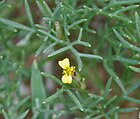Note: This is a project under development. The articles on this wiki are just being initiated and broadly incomplete. You can Help creating new pages.
Glossocardia bosvallia
Glossocardia bosvallia It is a small annual herb. It can grow upto 10-20cm in height. The plant is branched from the base and the branches are grooved.
Contents
[hide]- 1 Uses
- 2 Parts Used
- 3 Chemical Composition
- 4 Common names
- 5 Properties
- 6 Habit
- 7 Identification
- 8 List of Ayurvedic medicine in which the herb is used
- 9 Where to get the saplings
- 10 Mode of Propagation
- 11 Cultivation Details
- 12 Commonly seen growing in areas
- 13 Photo Gallery
- 14 References
- 15 External Links
Uses
Food
Glossocardia bosvallia can be used in Food. Whole plant is cooked as vegetable[2].
Parts Used
Chemical Composition
Common names
| Language | Common name |
|---|---|
| Kannada | Parpataka |
| Hindi | Pattharsuva |
| Malayalam | |
| Tamil | Parapalanam |
| Telugu | Parapalanam |
| Marathi | Phattar-suva |
| Gujarathi | |
| Punjabi | |
| Kashmiri | |
| Sanskrit | Charak |
| English | Patthar Suva |
Properties
Reference: Dravya - Substance, Rasa - Taste, Guna - Qualities, Veerya - Potency, Vipaka - Post-digesion effect, Karma - Pharmacological activity, Prabhava - Therepeutics.
Dravya
Rasa
Guna
Veerya
Vipaka
Karma
Prabhava
Nutritional components
Glossocardia bosvallia Contains the Following nutritional components like - Vitamin-B1, B2, B3 and C; Ursolic acid, Lupeol, Coumarin, Sterols, Lignins; Ionone glycosides; Phenyl propanoides; Flavonoides; Calcium, Copper, Iron, Magnesium, Manganese, Phosphorus, Potassium, Sodium, Zinc[2].
Habit
[[:Category:Habit - |]]
Identification
Leaf
| Kind | Shape | Feature |
|---|---|---|
| Alternately arranged | 1.5cm long | Pinnately cut into linear segment |
Flower
| Type | Size | Color and composition | Stamen | More information |
|---|---|---|---|---|
| Outer 3 bracts are 3m long | Yellow | Yellow borne in heads carried on slender stalks, In leaf axils or at the end of the branchs | {{{5}}} |
Fruit
| Type | Size | Mass | Appearance | Seeds | More information |
|---|---|---|---|---|---|
Other features
List of Ayurvedic medicine in which the herb is used
Where to get the saplings
Mode of Propagation
[[:Category:Index of Plants which can be propagated by |]]
Cultivation Details
Glossocardia bosvallia is available through August-December[2].
Commonly seen growing in areas
[[:Category:Herbs that are commonly seen in the region of |]], [[:Category:Herbs that are commonly seen in the region of |]], [[:Category:Herbs that are commonly seen in the region of |]], [[:Category:Herbs that are commonly seen in the region of |]], [[:Category:Herbs that are commonly seen in the region of |]].
Photo Gallery
References
- Jump up ↑ Indian Medicinal Plants by C.P.Khare
- ↑ Jump up to: 2.0 2.1 2.2 "Forest food for Northern region of Western Ghats" by Dr. Mandar N. Datar and Dr. Anuradha S. Upadhye, Page No.84, Published by Maharashtra Association for the Cultivation of Science (MACS) Agharkar Research Institute, Gopal Ganesh Agarkar Road, Pune
- Jump up ↑ [Chemistry]
- Jump up ↑ Kappatagudda - A Repertoire of Medicianal Plants of Gadag by Yashpal Kshirasagar and Sonal Vrishni, Page No. 200
External Links
- Ayurvedic Herbs known to be helpful to treat Sores
- Ayurvedic Herbs known to be helpful to treat Wound
- Herbs with Whole plant used in medicine
- Herbs with common name in Kannada
- Herbs with common name in Hindi
- Herbs with common name in Tamil
- Herbs with common name in Telugu
- Herbs with common name in Marathi
- Herbs with common name in Sanskrit
- Herbs with common name in English
- Habit -
- Index of Plants which can be propagated by
- Herbs that are commonly seen in the region of
- Herbs
- Pages without herbs images




